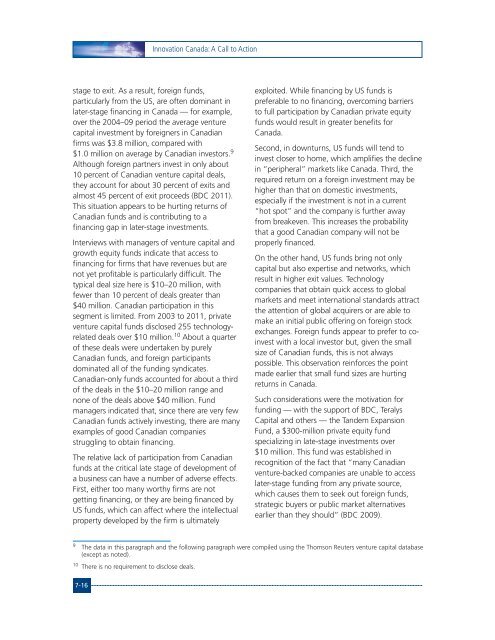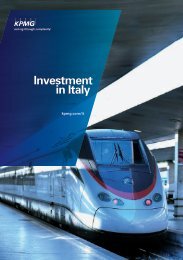Innovation Canada: A Call to Action
Innovation Canada: A Call to Action
Innovation Canada: A Call to Action
Create successful ePaper yourself
Turn your PDF publications into a flip-book with our unique Google optimized e-Paper software.
<strong>Innovation</strong> <strong>Canada</strong>: A <strong>Call</strong> <strong>to</strong> <strong>Action</strong>stage <strong>to</strong> exit. As a result, foreign funds,particularly from the US, are often dominant inlater-stage financing in <strong>Canada</strong> — for example,over the 2004–09 period the average venturecapital investment by foreigners in Canadianfirms was $3.8 million, compared with$1.0 million on average by Canadian inves<strong>to</strong>rs. 9Although foreign partners invest in only about10 percent of Canadian venture capital deals,they account for about 30 percent of exits andalmost 45 percent of exit proceeds (BDC 2011).This situation appears <strong>to</strong> be hurting returns ofCanadian funds and is contributing <strong>to</strong> afinancing gap in later-stage investments.Interviews with managers of venture capital andgrowth equity funds indicate that access <strong>to</strong>financing for firms that have revenues but arenot yet profitable is particularly difficult. Thetypical deal size here is $10–20 million, withfewer than 10 percent of deals greater than$40 million. Canadian participation in thissegment is limited. From 2003 <strong>to</strong> 2011, privateventure capital funds disclosed 255 technologyrelateddeals over $10 million. 10 About a quarterof these deals were undertaken by purelyCanadian funds, and foreign participantsdominated all of the funding syndicates.Canadian-only funds accounted for about a thirdof the deals in the $10–20 million range andnone of the deals above $40 million. Fundmanagers indicated that, since there are very fewCanadian funds actively investing, there are manyexamples of good Canadian companiesstruggling <strong>to</strong> obtain financing.The relative lack of participation from Canadianfunds at the critical late stage of development ofa business can have a number of adverse effects.First, either <strong>to</strong>o many worthy firms are notgetting financing, or they are being financed byUS funds, which can affect where the intellectualproperty developed by the firm is ultimatelyexploited. While financing by US funds ispreferable <strong>to</strong> no financing, overcoming barriers<strong>to</strong> full participation by Canadian private equityfunds would result in greater benefits for<strong>Canada</strong>.Second, in downturns, US funds will tend <strong>to</strong>invest closer <strong>to</strong> home, which amplifies the declinein “peripheral” markets like <strong>Canada</strong>. Third, therequired return on a foreign investment may behigher than that on domestic investments,especially if the investment is not in a current“hot spot” and the company is further awayfrom breakeven. This increases the probabilitythat a good Canadian company will not beproperly financed.On the other hand, US funds bring not onlycapital but also expertise and networks, whichresult in higher exit values. Technologycompanies that obtain quick access <strong>to</strong> globalmarkets and meet international standards attractthe attention of global acquirers or are able <strong>to</strong>make an initial public offering on foreign s<strong>to</strong>ckexchanges. Foreign funds appear <strong>to</strong> prefer <strong>to</strong> coinvestwith a local inves<strong>to</strong>r but, given the smallsize of Canadian funds, this is not alwayspossible. This observation reinforces the pointmade earlier that small fund sizes are hurtingreturns in <strong>Canada</strong>.Such considerations were the motivation forfunding — with the support of BDC, TeralysCapital and others — the Tandem ExpansionFund, a $300-million private equity fundspecializing in late-stage investments over$10 million. This fund was established inrecognition of the fact that “many Canadianventure-backed companies are unable <strong>to</strong> accesslater-stage funding from any private source,which causes them <strong>to</strong> seek out foreign funds,strategic buyers or public market alternativesearlier than they should” (BDC 2009).9 The data in this paragraph and the following paragraph were compiled using the Thomson Reuters venture capital database(except as noted).10 There is no requirement <strong>to</strong> disclose deals.7-16
















